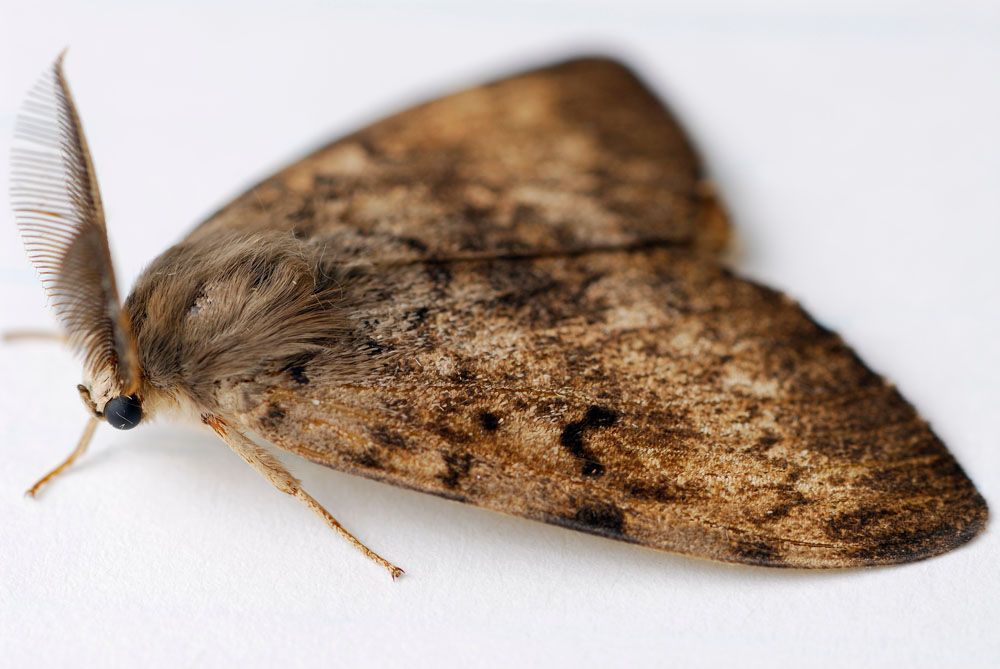
Gypsy Moth – Lymantria dispar
Gypsy Moth
Introduction of Gypsy Moth:
Gypsy moths are among the most destructive pests of hardwood forests and urban areas, defoliating a million or more wooded acres each year. The first gypsy moth epidemic happened in 1889. The gypsy moth had spread throughout the Northeast by 1987 and is now widespread over much of the Eastern United States. They are spread over large areas primarily by shipment of infested nursery stock or any object on which eggs may be deposited. In the mid-1800s, gypsy moth larvae evaluated for silk production were blown from a window sill in Medford, Massachusetts.
How to identify gypsy moths?
Gypsy moths’ characteristics make them easily distinguishable from other leaf-feeding caterpillars. Gypsy moths are caterpillar-eating caterpillars that can grow up to 50 mm in length. They will be about 2 inches long, highly hairy, and have five pairs of blue spots followed by six pairs of red dots along their back when completely developed. Adults are hairy moths with 1-1/2 – 2 inch wingspan that is grey (male) or white (female). Even though both sexes have wings, the female moth does not fly.
The life cycle of a gypsy moth:
The female gypsy moth deposits an egg mass, which is covered with body hairs to function as protection and to protect the eggs from predators. The female gypsy moth dies shortly after laying the egg mass, and the eggs survive the winter until temperatures increase in the spring and hatching begins. Small black-headed gypsy moth caterpillars hatch and ascend to the tops of trees, where they may begin to feed on foliage, or they may dangle on silk threads and drift in the wind to colonize other trees. Caterpillars of the gypsy moth have five or six instars and eat from late April until mid-June. Most feeding happens at night to protect caterpillars from severe heat and bird predation during the day. Caterpillars cease eating when they reach maturity and transform into pupae. 7-10 days later, adult moths appear. Each year, one generation is born.
How to know if I have a gypsy moth feeding on my trees?
Many insects eat on tree leaves, yet there is just one gypsy moth. Caterpillars of the gypsy moth feature pairs of red and blue patches on their backs and long, black hairs. They feed on the leaves of oaks and other favored host trees such as aspen, apple, basswood, birch, crabapple, willow, and many other species of trees throughout early and mid-summer, often from mid-to-late May to early July.
Damages caused by gypsy moth:
Most healthy hardwoods can tolerate gypsy moth defoliation for one to many years. On the other hand, white oak is very vulnerable to this insect, and hemlock and pine can be completely killed in a single season if 90 to 95 percent of the foliage is consumed. The understory and partially-shaded trees (weaker trees) are the first to be destroyed by recurrent defoliation in hardwood stands. Other defoliators, disease, and drought can exacerbate the decline and mortality of afflicted trees. When in high numbers, roaming caterpillars and their droppings may be a significant annoyance in forested residential and tourist locations.
How to Control:
- The final stage in totally controlling Gypsy Moth Caterpillars and limiting the likelihood of re-infestation is prevention. Spray your yard with Reclaim IT every three months to keep their numbers under control, especially during the spring and fall seasons when they are most prone to appear.
- Another preventive action you may take is to avoid growing plants that the Gypsy Moth consumes. Roses, ivy, citrus trees, elm, and oaks can all help to enhance the presence of this deadly caterpillar.
- Maintain as much cleanliness as possible in your yard. Remove any abandoned goods, dead branches, stumps, or other structures in areas where the adult female moth is likely to lay egg masses. Any egg masses discovered should be destroyed.
- The Gypsy Moth Trap is used to measure the moth population and may also keep male moths from closing in on females.
- Tanglefoot Pest Barrier can be applied to tree trunks to limit caterpillar migration into and out of the canopy.
- To destroy gypsy moth caterpillars, spray the leaves of trees with Bacillus thuringiensis, var. kurstaki, or Monterey Garden Insect Spray (Spinosad). Sprays should be sprayed for the greatest effects when caterpillars are young, less than one inch long. In cases where population density is high, two (or more!) applications five days apart may be required.
- Botanical pesticides with the lowest toxicity should only be used as a last option. These natural insecticides, derived from plants with insecticidal characteristics, have fewer negative side effects than synthetic chemicals and degrade faster in the environment.
